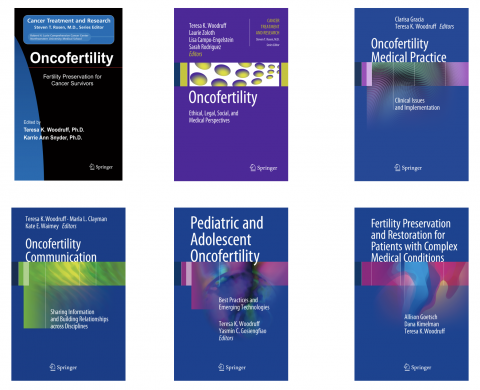The six books on Oncofertility cover the overall scope of the reproductive considerations for cancer patients and research; legal, ethical, and religious condiderations; clinical guidelines for providers; communication strategies for the field, pediatric and adolescent best practices, and fertility preservation and restoration for patients with complex medical conditions.

Oncofertility: Fertility Preservation for Cancer Survivors Woodruff, TK., & Snyder, K. (Eds)
While cancer survival rates have increased steadily over the last several decades, particularly among younger patients, the more aggressive forms of treatment that have made this possible often compromise a cancer patient's ability to later have biological children. In the past, pregnancy after cancer was largely unheard of. Today it is increasingly a possibility due to high survivorship rates in general and emerging reproductive technologies that give patients and their families options at the time of diagnosis to ensure a patient's future fertility (cryopreservation of ovarian tissue). Oncofertility has emerged as an interdisciplinary field bridging biomedical, social sciences and examines issues regarding an individual's fertility options, choice and goals in light of cancer diagnosis, treatment and survivorship. Written by leaders in this evolving field, the volume covers various aspects: medical, ethical and social.
Oncofertility: Ethical, Legal, Social, and Medical Perspectives Woodruff, TK., Zoloth, L., Campo-Engelstein L., Rodriguez, SB. (Eds)
Oncofertility has emerged as a way to address potential lost or impaired fertility in those with a history of cancer. Active biomedical research is developing new ways to help those afflicted with cancer to preserve their ability to have biological children. Oncofertility: Ethical, Legal, Social, and Medical Perspectives moves beyond oncofertility as a science and medical technology and begins to address the social, legal, and ethical ramifications of this emerging field. Dr. Teresa K. Woodruff establishes a team of oncologists, fertility specialists, social scientists, and education and policy makers to engage in an interdisciplinary discussion on the clinical care of women who will lose their fertility due to cancer treatment. "Cancer and its treatment will often compromise fertility. Concerns relevant to reproduction remains one of the most important issues for patients. In this text renown experts discuss the spectrum of critical issues embraced by Oncofertility." - Steven T. Rosen, M.D. Series Editor
Oncofertility Medical Practice: Clinical Issues and Implementation Woodruff, TK., & Gracia, C. (Eds).
Oncofertility Medical Practice: Clinical Issues and Implementation is the third in a series of timely and indispensable books on fertility preservation for cancer patients—the first one focused on advances in basic science research and the second one offered ethical, legal, and social perspectives on the theme. This book elucidates the latest practices and emerging treatments in oncofertility and provides necessary information on the successes, risks, and limitations of fertility preserving technologies. Authoritative and insightful, written by an impressive multi-disciplinary cadre of specialists, this book is a valuable up-to-date resource for all those practicing in this demanding field.
Oncofertility Communication: Sharing Information and Building Relationships across Disciplines Woodruff, TK., Clayman, ML., Waimey KE. (Eds).
Oncofertility Communication describes and addresses the myriad channels through which the multiple audiences involved in Oncofertility can be served with appropriate and accurate information about cancer-related fertility issues. The text answers frequently asked questions and provides invaluable insights to scientific and health care professionals about communication among the diverse Oncofertility audiences. It incorporates timely discussions about traditional and emerging electronic communication tools and discusses the impact of health care policy changes on the Oncofertility field.
Pediatric and Adolescent Oncofertility: Best Practices and Emerging Technologies Woodruff, TK. & Gosiengfiao, YC. (Eds).
Reflecting the increasing interest in fertility management for pediatric and adolescent patients and fulfilling an urgent need to have a comprehensive guide to the management of these individuals, this is the first book of its kind to present a comprehensive discussion of pediatric and adolescent oncofertility. It carefully examines the impact of pediatric cancer and cancer therapy on fertility and presents both current and emerging fertility preservation techniques for both males and females, such as cryopreservation. Fertility concerns beyond cancer are also discussed, including disorders of sexual differentiation, gender dysphoria and thalassemia. Practical chapters on pediatric oncofertility in the clinic round out the book, covering setting up a practice, counseling and consent, disclosure and insurance considerations. Concluding chapters document fertility preservation techniques and outcomes internationally, with contributions from Portuguese, Brazilian and Japanese authors. Timely and wide-ranging, Pediatric and Adolescent Oncofertility is an ideal resource for reproductive medicine specialists, pediatric oncologists, and primary care physicians treating pediatric and adolescent cancer patients looking to protect fertility options.
Fertility Preservation and Restoration for Patients with Complex Medical Conditions Goetsch A., Kimelman D., Woodruff, TK. (Eds).
This unique book is a comprehensive guide for healthcare providers who treat patients with complex medical conditions but lack the resources to address fertility and sexuality concerns and help patients navigate their fertility decision-making process. It presents up-to-date information concerning fertility preservation and restoration for patients with hereditary cancer syndromes, disorders of sex development, hematologic diseases, genetic disorders of gonadal dysfunction, immunologic diseases, gynecologic diseases, endocrine disorders, and autoimmune and inflammatory diseases. Utilizing a practical, user-friendly format, each chapter discusses the epidemiology, classification, risk factors and/or clinical manifestations, and diagnosis and treatment modalities specific to each condition, as well as the effect of it or its treatment on fertility and unique options that may exist.
Complex medical conditions are inherently difficult to manage, and reproductive interventions are often not part of the conversation. As such, Fertility Preservation and Restoration for Patients with Complex Medical Conditions will be an excellent resource for primary care physicians, obstetrician/gynecologists, endocrinologists, oncologists, and other health professionals working with patients with fertility concerns.
This book, together with Oncofertility: Fertility Preservation for Cancer Survivors; Oncofertility: Ethical, Legal, Social, and Medical Perspectives; Oncofertility Medical Practice: Clinical Issues and Implementation; Oncofertility Communication: Sharing Information and Building Relationships across Disciplines; and Pediatric and Adolescent Oncofertility: Best Practices and Emerging Technologies, provides scientific and medically relevant information on fertility preservation from all vantage points and is an indispensable series for those interested in fertility management in cancer or complex settings.


